ISABELLE BNL, cancelled in 1983 Relativistic Heavy Ion Collider BNL, 2000–present | Super Proton Synchrotron CERN, 1981–1984 Tevatron Fermilab, 1987–2011 Superconducting Super Collider Cancelled in 1993 | |
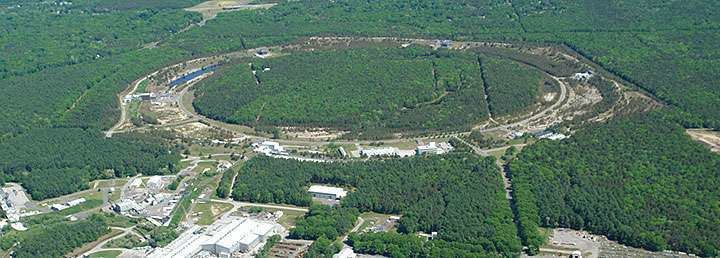 | ||
Relativistic heavy ion collider
The Relativistic Heavy Ion Collider (RHIC /ˈrɪk/) is one of only two operating heavy-ion colliders, and the only spin-polarized proton collider ever built. Located at Brookhaven National Laboratory (BNL) in Upton, New York, and used by an international team of researchers, it is the only operating particle collider in the US. By using RHIC to collide ions traveling at relativistic speeds, physicists study the primordial form of matter that existed in the universe shortly after the Big Bang. By colliding spin-polarized protons, the spin structure of the proton is explored.
Contents
- Relativistic heavy ion collider
- The accelerator
- The experiments
- Current results
- The future
- Possible closure under flat nuclear science budget scenarios
- Critics of high energy experiments
- Financial information
- RHIC in fiction
- References
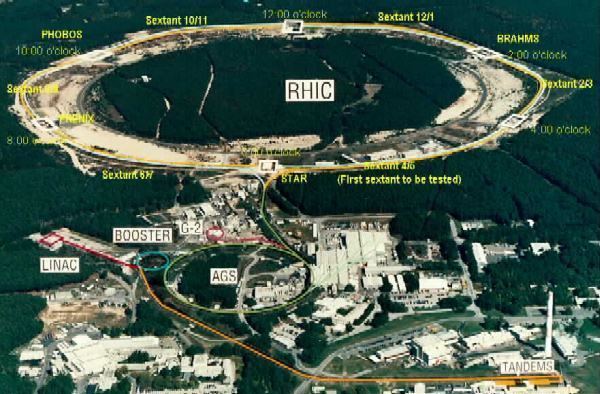
RHIC is now the second-highest-energy heavy-ion collider in the world. As of November 7, 2010, the Large Hadron Collider (LHC) has collided heavy ions of lead at higher energies than RHIC. The LHC operating time for ions (lead-lead and lead-proton collisions) is limited to about one month per year.
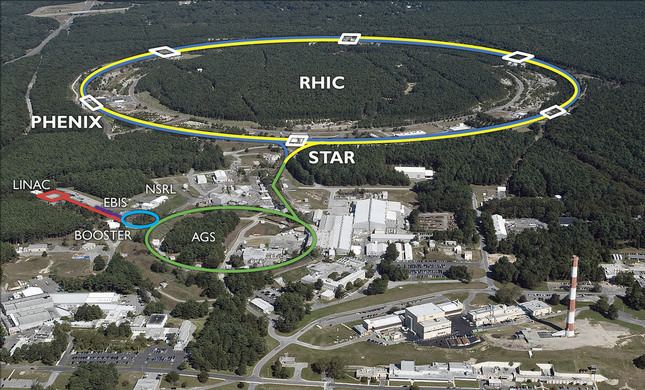
In 2010, RHIC physicists published results of temperature measurements from earlier experiments which concluded that temperatures in excess of 345 MeV (4 terakelvins or 7 trillion degrees Fahrenheit) had been achieved in gold ion collisions, and that these collision temperatures resulted in the breakdown of "normal matter" and the creation of a liquid-like quark–gluon plasma.
Relativistic heavy ion collider
The accelerator
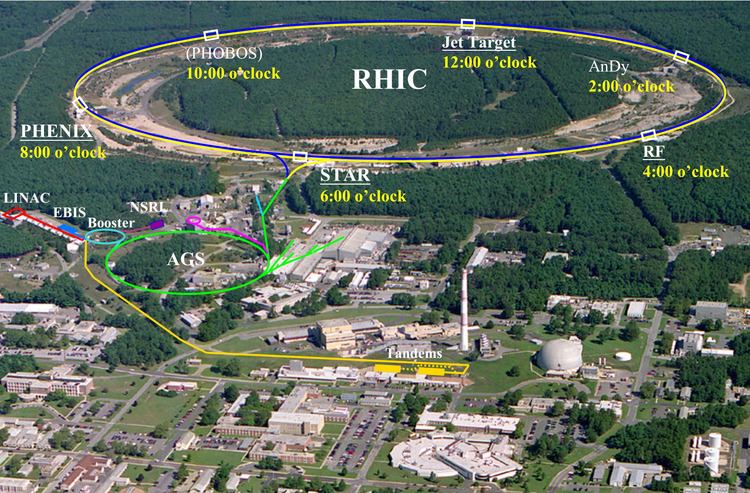
RHIC is an intersecting storage ring particle accelerator. Two independent rings (arbitrarily denoted as "Blue" and "Yellow" rings) circulate heavy ions and/or protons in opposite directions and allow a virtually free choice of colliding positively charged particles (the eRHIC upgrade will allow collisions between positively and negatively charged particles). The RHIC double storage ring is itself hexagonally shaped and 7003383400000000000♠3834 m long in circumference, with curved edges in which stored particles are deflected and focused by 1,740 superconducting magnets using niobium-titanium conductors. The dipole magnets operate at 7000345000000000000♠3.45 T. The six interaction points (between the particles circulating in the two rings) are at the middle of the six relatively straight sections, where the two rings cross, allowing the particles to collide. The interaction points are enumerated by clock positions, with the injection near 6 o'clock. Two large experiments, STAR and PHENIX, are located at 6 and 8 o'clock respectively.
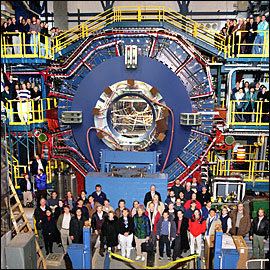
A particle passes through several stages of boosters before it reaches the RHIC storage ring. The first stage for ions is the electron beam ion source (EBIS), while for protons, the 6989320435297400000♠200 MeV linear accelerator (Linac) is used. As an example, gold nuclei leaving the EBIS have a kinetic energy of 6987320435297400000♠2 MeV per nucleon and have an electric charge Q = +32 (32 of 79 electrons stripped from the gold atom). The particles are then accelerated by the Booster Synchrotron to 6989160217648700000♠100 MeV per nucleon, which injects the projectile now with Q = +77 into the Alternating Gradient Synchrotron (AGS), before they finally reach 6991141952836748199♠8.86 GeV per nucleon and are injected in a Q = +79 state (no electrons left) into the RHIC storage ring over the AGS-to-RHIC Transfer Line (AtR).
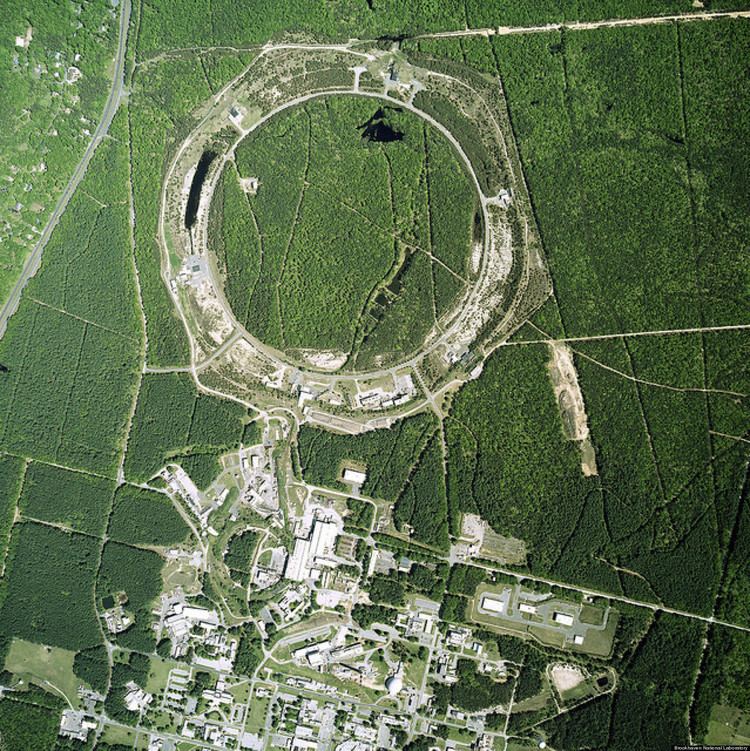
To date the types of particle combinations explored at RHIC are p + p, p + Al, p + Au, d + Au, h + Au, Cu + Cu, Cu + Au, Au + Au and U + U. The projectiles typically travel at a speed of 99.995% of the speed of light. For Au + Au collisions, the center-of-mass energy is typically 6992320435297399999♠200 GeV per nucleon-pair, and was as low as 6991123367589499000♠7.7 GeV per nucleon-pair. An average luminosity of 7026200000000000000♠2×1026 cm−2s−1 was targeted during the planning. The current average Au + Au luminosity of the collider is 7027870000000000000♠87×1026 cm−2s−1, 44 times the design value. The heavy ion luminosity is substantially increased through stochastic cooling.
One unique characteristic of RHIC is its capability to collide polarized protons. RHIC holds the record of highest energy polarized protons. Polarized protons are injected into RHIC and preserve this state throughout the energy ramp. This is a difficult task that can only be accomplished with the aid of Siberian snakes (in RHIC a chain 4 helical dipole magnets). Run-9 achieved center-of-mass energy of 6992801088243500000♠500 GeV on 12 February 2009. In Run-13 the average p + p luminosity of the collider reached 7032160000000000000♠160×1030 cm−2s−1, with a time and intensity averaged polarization of 52%.
AC dipoles have been used in non-linear machine diagnostics for the first time in RHIC.
The experiments
There are two detectors continuing to operate at RHIC: STAR (6 o'clock, and near the AGS-to-RHIC Transfer Line) and PHENIX (8 o'clock). PHOBOS (10 o'clock) completed its operation in 2005, and BRAHMS (2 o'clock) in 2006.
Among the two larger detectors, STAR is aimed at the detection of hadrons with its system of time projection chambers covering a large solid angle and in a conventionally generated solenoidal magnetic field, while PHENIX is further specialized in detecting rare and electromagnetic particles, using a partial coverage detector system in a superconductively generated axial magnetic field. The smaller detectors have larger pseudorapidity coverage, PHOBOS has the largest pseudorapidity coverage of all detectors, and tailored for bulk particle multiplicity measurement, while BRAHMS is designed for momentum spectroscopy, in order to study the so-called "small-x" and saturation physics. There is an additional experiment, PP2PP (now part of STAR), investigating spin dependence in p + p scattering.
The spokespersons for each of the experiments are:
Current results
For the experimental objective of creating and studying the quark–gluon plasma, RHIC has the unique ability to provide baseline measurements for itself. This consists of the both lower energy and also lower mass number projectile combinations that do not result in the density of 200 GeV Au + Au collisions, like the p + p and d + Au collisions of the earlier runs, and also Cu + Cu collisions in Run-5.
Using this approach, important results of the measurement of the hot QCD matter created at RHIC are:
While in the first years, theorists were eager to claim that RHIC has discovered the quark–gluon plasma (e.g. Gyulassy & McLarren), the experimental groups were more careful not to jump to conclusions, citing various variables still in need of further measurement. The present results shows that the matter created is a fluid with a viscosity near the quantum limit, but is unlike a weakly interacting plasma (a widespread yet not quantitatively unfounded belief on how quark–gluon plasma looks).
A recent overview of the physics result is provided by the RHIC Experimental Evaluations 2004, a community-wide effort of RHIC experiments to evaluate the current data in the context of implication for formation of a new state of matter. These results are from the first three years of data collection at RHIC.
New results were published in Physical Review Letters on February 16, 2010, stating the discovery of the first hints of symmetry transformations, and that the observations may suggest that bubbles formed in the aftermath of the collisions created in the RHIC may break parity symmetry, which normally characterizes interactions between quarks and gluons.
The RHIC physicists announced new temperature measurements for these experiments of up to 4 trillion kelvins, the highest temperature ever achieved in a laboratory. It is described as a recreation of the conditions that existed during the birth of the Universe.
The future
RHIC began operation in 2000 and until November 2010 was the most powerful heavy-ion collider in the world. The Large Hadron Collider (LHC) of CERN, while used mainly for colliding protons, operates with heavy ions for about one month per year. The LHC will eventually operate 28 times higher ion energies, although current LHC operation is at half this energy. As of 2014 RHIC and the LHC are the only operating hadron colliders in the world.
Due to the longer operating time per year, a greater number of colliding ion species and collision energies can be studied at RHIC. In addition and unlike the LHC, RHIC is also able to accelerate spin polarized protons, which would leave RHIC as the world's highest energy accelerator for studying spin-polarized proton structure.
A planned major upgrade is eRHIC: The construction of a 10 GeV high intensity electron/positron beam facility, allowing electron-ion collisions. At least one new detector will have to be built to study the collisions. A recent review is given by A. Deshpande et al.
Possible closure under flat nuclear science budget scenarios
In late 2012, the Nuclear Science Advisory Committee (NSAC) was asked to advise the Department of Energy's Office of Science and the National Science Foundation how to implement the nuclear science long range plan written in 2007, if future nuclear science budgets continue to provide no growth over the next four years. In a narrowly decided vote, the NSAC committee showed a slight preference, based on non-science related considerations, for shutting down RHIC rather than canceling the construction of the Facility for Rare Isotope Beams (FRIB).
By October 2015, the budget situation improved. Maintaining existing scientific facilities became a priority, due to a greater need for neutrino studies. This means that RHIC can continue operations into the next decade.
Critics of high-energy experiments
Before RHIC started operation, critics postulated that the extremely high energy could produce catastrophic scenarios, such as creating a black hole, a transition into a different quantum mechanical vacuum (see false vacuum), or the creation of strange matter that is more stable than ordinary matter. These hypotheses are complex, but many predict that the Earth would be destroyed in a time frame from seconds to millennia, depending on the theory considered. However, the fact that objects of the Solar System (e.g., the Moon) have been bombarded with cosmic particles of significantly higher energies than that of RHIC and other man-made colliders for billions of years, without any harm to the Solar System, were among the most striking arguments that these hypotheses were unfounded.
The other main controversial issue was a demand by critics for physicists to reasonably exclude the probability for such a catastrophic scenario. Physicists are unable to demonstrate experimental and astrophysical constraints of zero probability of catastrophic events, nor that tomorrow Earth will be struck with a "doomsday" cosmic ray (they can only calculate an upper limit for the likelihood). The result would be the same destructive scenarios described above, although obviously not caused by humans. According to this argument of upper limits, RHIC would still modify the chance for the Earth's survival by an infinitesimal amount.
Concerns were raised in connection with the RHIC particle accelerator, both in the media and in the popular science media. The risk of a doomsday scenario was indicated by Martin Rees, with respect to the RHIC, as being at least a 1 in 50,000,000 chance. With regards to the production of strangelets, Frank Close, professor of physics at the University of Oxford, indicates that "the chance of this happening is like you winning the major prize on the lottery 3 weeks in succession; the problem is that people believe it is possible to win the lottery 3 weeks in succession." After detailed studies, scientists reached such conclusions as "beyond reasonable doubt, heavy-ion experiments at RHIC will not endanger our planet" and that there is "powerful empirical evidence against the possibility of dangerous strangelet production."
The debate started in 1999 with an exchange of letters in Scientific American between Walter L. Wagner and F. Wilczek, in response to a previous article by M. Mukerjee. The media attention unfolded with an article in UK Sunday Times of July 18, 1999 by J. Leake, closely followed by articles in the U.S. media. The controversy mostly ended with the report of a committee convened by the director of Brookhaven National Laboratory, J. H. Marburger, ostensibly ruling out the catastrophic scenarios depicted. However, the report left open the possibility that relativistic cosmic ray impact products might behave differently while transiting earth compared to "at rest" RHIC products; and the possibility that the qualitative difference between high-E proton collisions with earth or the moon might be different than gold on gold collisions at the RHIC. Wagner tried subsequently to stop full-energy collision at RHIC by filing Federal lawsuits in San Francisco and New York, but without success. The New York suit was dismissed on the technicality that the San Francisco suit was the preferred forum. The San Francisco suit was dismissed, but with leave to refile if additional information was developed and presented to the court.
On March 17, 2005, the BBC published an article implying that researcher Horaţiu Năstase believes black holes have been created at RHIC. However, the original papers of H. Năstase and the New Scientist article cited by the BBC state that the correspondence of the hot dense QCD matter created in RHIC to a black hole is only in the sense of a correspondence of QCD scattering in Minkowski space and scattering in the AdS5 × X5 space in AdS/CFT; in other words, it is similar mathematically. Therefore, RHIC collisions might be described by mathematics relevant to theories of quantum gravity within AdS/CFT, but the described physical phenomena are not the same.
Financial information
The RHIC project is sponsored by the United States Department of Energy, Office of Science, Office of Nuclear Physics. It had a line-item budget of 616.6 million U.S. dollars. The annual operational budgets were:
The total investment by 2005 is approximately 1.1 billion U.S. dollars. Though operation under the fiscal year 2006 federal budget cut was uncertain, a key portion of the operational cost (13 million U.S. dollars) was contributed privately by a group close to Renaissance Technologies of East Setauket, New York.
